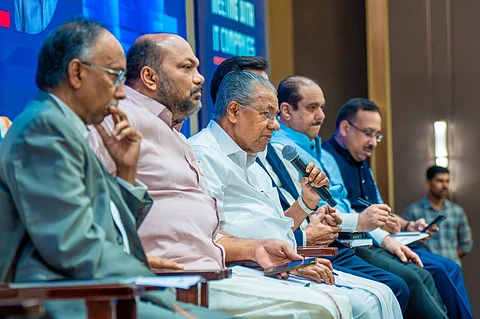

Kerala Chief Minister Pinarayi Vijayan launched KaWaCHaM, one of the world’s fastest weather alert systems on January 21, 2025. It is designed to enhance rescue and rehabilitation efforts during extreme weather events driven by climate change.
The project is significant, given the annual climate emergencies the state has been experiencing since the massive floods of 2018 and the devastating Wayanad landslide last year that resulted in the deaths of 420 people.
According to the Kerala State Disaster Management Authority (KSDMA), KaWaCHaM is an advanced disaster warning system that integrates alerts, sirens, and global weather models to improve the state’s early disaster preparedness and public safety.
‘KaWaCHaM’ stands for Kerala Warnings Crisis and Hazards Management System, and the word kavacham in Malayalam translates to ‘shield’, symbolising protection.
KSDMA developed KaWaCHaM with funding from the National Disaster Management Authority and the World Bank as part of the National Cyclone Risk Mitigation Project. This advanced system unifies Kerala’s entire early warning mechanism into one framework.
Key features of the system are hazard assessment, alert issuance, and action planning according to threat levels.
The project aims to install 126 sirens and strobe lights on tall towers, government buildings, and schools. The system will include pre-recorded voice messages and audio alerts to provide various warnings.
Under the project, the state integrates all early warning systems into a framework that disseminates knowledge, issues warnings, monitors developing crises and ensures responses.
The ambitious warning network system, headed by the state emergency operation centre, will operate at the taluk (subdistrict) level and cover all vulnerable areas.
“KaWaCHaM has been created to assess hazards, issue alerts, and take action based on the threat level. The Orange Book of Disaster Management has been updated to cover all-natural disasters, including pandemic management. This resource assists officials in addressing various issues, as the Standard Operating Procedures (SOPs) are in place; they need to monitor the State Emergency Operations Center (SEOC) warnings,” said Shekar Kuriakose, KSDMA member secretary.
KaWaCHaM collects data from various sources, including weather networks such as India Meteorological Department, INCOIS, and CWC, private and public agencies, social media networks, and the Internet. The warnings will cover sea attacks, heavy rainfall, strong winds, and extreme heat.
“We have developed various levels of alerts for different types of disasters, including the associated sirens and signals,” said Kuriakose. This system is expected to significantly benefit regions of the state that are often impacted by disasters such as floods and landslides.
“Each siren has three colours—red, yellow, and orange—in the strobe light and is equipped with eight loudspeakers. These sirens can broadcast warnings up to 1,200 metres away and provide essential information about emergency camps and safety precautions. Additionally, special cameras have been installed to monitor and ensure the proper functioning of the sirens,” Kuriakose added.
Officials have announced that the state is in discussions with various social media platforms, including WhatsApp, Facebook, Twitter, and Google API, to implement community alerts similar to those used in the US. Existing volunteer networks, such as Samoohika Sannadhasena, will be trained in areas like preparedness, rescue, and rehabilitation. Additionally, communication systems will be enhanced to include support for individuals with disabilities, including sign language and audio options.
Shelter networks have documented 20,000 buildings with the capacity to house 400,000 people, including 17 specialised shelters across Kerala.
The State Emergency Operations Centre will coordinate the KaWaCHaM system in Kerala. Thiruvananthapuram and Ernakulam have the highest number of sirens, with 13 each. In contrast, Kottayam, Idukki, and Wayanad districts have the fewest sirens, with only five each.